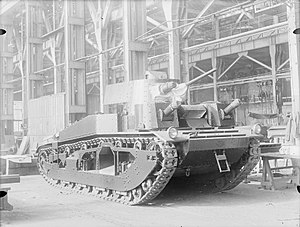Medium Mk III
| Medium Mk III | |
|---|---|
 |
|
| Type | Medium tank |
| Place of origin |
|
| Service history | |
| Used by | British Army |
| Wars | none |
| Production history | |
| Designed | 1930 (A6 – 1926) |
| Manufacturer |
Vickers-Armstrong Royal Ordnance Factory |
| No. built | 3 |
| Specifications | |
| Weight | 16 tons |
| Length | 21 ft 6 in (6.55 m) |
| Width | 8 ft 9 in (2.67 m) |
| Height | 9 ft 2 in (2.79 m) |
| Crew | 7 |
|
|
|
| Armour | 9-14 mm |
|
Main
armament |
3 pounder gun |
|
Secondary
armament |
3 × 0.303 Vickers machine guns |
| Engine |
Armstrong Siddeley air-cooled V8 180 hp |
|
Operational
range |
120 miles (190 km) |
| Speed | 30 mph (48 km/h) |
The Medium Mark III was a medium tank developed in the United Kingdom during the post war. The tank was unsuccessful with only 3 built. The design did not directly derive from earlier Medium Mark II tank.
In 1926, the British War Office wanted to replace their existing Mark II tanks with a new design. In May the Royal Tank Corps Centre was asked for its opinion, which it submitted in July. One of the requirements was a weight limit of 15.5 long tons (15.7 t), which led to the nickname "16-tonners". Other specifications included that it could transported by rail, a sufficient supply of lubrication oil to match the range of the tank (dictated by the fuel carried), a wireless set, a gun capable of defeating enemy armour at a range of at least a 1,000 yd (910 m), fuel tanks external to the main compartments and bottom armour sufficient to withstand heavy machine-gun fire, when exposed climbing a crest. Furthermore the machine should be as silent as possible, as with previous types the engine noise tended to incapacitate the crew.
The War Office added some extra requirements: a separate engine compartment; superior steering capacity and 13 mm (0.51 in) frontal armour with 9 mm (0.35 in) thickness for the other plates.
In September Vickers, given the order to build a prototype, proposed a first design based on the Vickers A1E1 Independent, with the fighting compartment in front and the engine compartment at the back. There would be a central two-man turret with a 3-pounder 1.9 in (47 mm) and a coaxial machine-gun; it was intended to house the commander and a special observer, with a cupola each. In the front of the hull were to be placed two secondary machine-gun turrets, each with a twin Vickers machine gun. A third machine-gun turret was intended to be mounted at the back of the vehicle, behind the main turret, which would be armed with an anti-aircraft (AA) weapon. A crew of seven men was needed. Maximum armour would be 13 mm (0.51 in) and basis armour 6.5 mm (0.26 in), limiting the weight to fourteen tons. Riveted plates were used. The total fuel supply would be 120 imp gal (550 l): ten in a small tank inside, gravity feeding the engine; the remainder in external tanks on the fenders. Two engine options were indicated a 120 hp engine would allow for a speed of 14 mph (23 km/h) and a 180 hp engine would raise this to 20 mph (32 km/h).
...
Wikipedia
